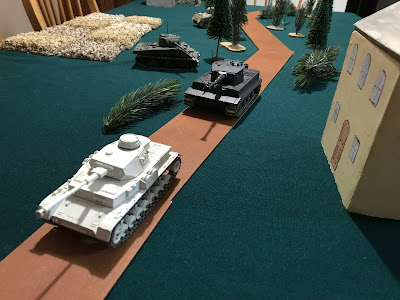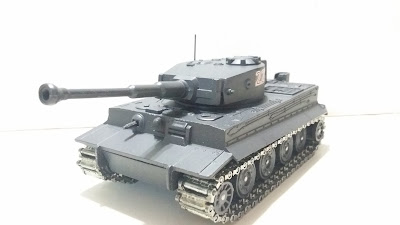I have been itching for several days to get a game of John Lambshead's
One Hour Skirmish Wargames (OHSW) on the table to try out the rules.
For the scenario, I decided to go with the first one in the book, Capture the Cannon, but, as I have no Napoleonic figures and inspired by Featherstone's and Robinson's
Battles with Model Tanks: Wargaming 1914-1975, I turned it into a tank recovery mission.
Somewhere on the Eastern Front, a squad of Germans has been sent to secure a disabled Tiger I before the recovery crew and vehicles can arrive. As they arrive, they see that the Soviets have already surrounded the tank.
The forces were a mishmash of eye-balling the British and French lists and what I wanted to put on the table. I really wanted to use my TSSD Russians and winter Germans, which are not painted and likely never will be (I just love the sculpts) so that limited my forces considerably, although the Soviets did get the sniper. For cavalry, I gave the Germans a kublewagen - not exactly a 1:1 correspondence there, but it would do.
 |
| Aerial photo of encounter between Russian and German forces. |
The Germans won the initiative Ace of Hearts to Ace of Clubs and then drew the King of Diamonds (13 points). It looked like it was going to be a long day for the Soviets.
 |
| Artsy over-the-shoulder shot of German squad LMG and rifleman as they knock down two Russians guarding the objective. |
But, after just 7 points of mostly shooting (resulting in two downed Russians), the first Joker came up and the turn ended!
Both sides easily passed the morale test. One of the Russians was a casualty, while the other was back in the fight.
Turn 2, the Germans won initiative Jack vs an eight, and drew 8 points to spend. I figured the Germans were trying to suppress the Russians before advancing, so again, I spent points shooting, only to have their second Joker come up before they used all their points.
With only 5 turns to reach their objective, time was running out fast. On the plus side, two Russians were removed as casualties.
The Germans won the initiative on turn 3, King vs Jack, and then drew the Queen of Hearts for 12 points of action. The squad LMG opened fire and then the kublewagen raced up to the tank and opened fire with the machine gun.
 |
| The kublewagen finally moves and opens fire with a hail of bullets! |
 |
| Perspective shot. Not pictured, Soviet sniper - just beyond the left edge of this photo. |
|
The next shot taken resulted in a Joker being drawn by a Russian as part of their defensive draw.
THREE TURNS DOWN.
Again the Germans won the initiative, nine vs five, but they only drew the Three of Hearts and didn't accomplish much.
Finally, the Soviets got their chance to do something! And they drew the Five of Clubs.
Not exactly a great start, but I hadn't noticed I had set up a German officer in way that the sniper had a clear shot. She didn't even need the 2nd card - she downed him on the first shot!
The two SMGs nearest the kublewagen opened fire and delivered a cumulative 18 points of damage - it went up in a Hollywood fireball.
 |
| Boom! |
Surprisingly, no Jokers had been drawn, so the Germans drew again - the King of Spades for 13 points. Retribution would be swift! With one turn left, they were going to have to move quickly and with 13 points surely they could do it.
On the first shot fired, the defending Russian drew a Joker!
Turn 5 would be the last turn regardless of outcomes. The Germans won the initiative again, five to Ace, but would it be enough?
I decided they would have to rush forward in order to get some decisive close combat in if they were to have any chance of breaking the Soviets who had thus far avoided that fate.
It was too little too late - after some back and forth, two phases each - when the next Joker came up, this is how things looked:
 |
| End game. The Soviets losses were heavy but the sons and daughter of Mother Russia were victorious! |
Impressions
From start to finish, it was around an hour and a half. However, a good fifteen of those minutes was me trying to find a second deck of cards! Had I known where the second deck was, and had I been more familiar with the rules, an hour would have been definitely possible.
As a fan of card-based initiative (
G.A.S.L.I.G.H.T.) or action
resolution (
IN-RADIC, Kodoka Trail), I am predisposed to like OHSW, so
I was not surprised that I found the game enjoyable. I will definitely play again.
I played with 1/32 figures but left the ranges as written. Realistically, even with 28mm figures,
all weapons would be the entire table. However, the shortened ranges for
the SMGs and pistols make it feel movie-like, which I'm OK with. If
you're not, get rid of the range limits or adjust to taste -maybe one card for an SMG beyond
18, two under.
I had one thought right of the bat: the scenario map is pretty sparse on details.
In fact it is about as simple as you can get for this scenario - a road with a cannon/tank on it. It would be
helpful for those new to wargaming (or not great at terrain placement)
for some kind of system or more populated map. Admittedly, terrain
placement systems are available in a lot of rule sets, and they are all pretty
much the same, but for a newbie, it could be helpful to have it included.
Speaking of the scenario. I have read a few complaints about the lack of generic scenarios in this book compared to
One Hour Wargames.
I would argue that all scenarios are adaptable to one degree or other.
While I didn't do a great job substituting the forces on a points basis(not really a points player though anyway), I just swapped out the cannon for a disabled tank, British for Soviets, and French for Germans, picked out some figures and voila, the first scenario became a WW2 scenario. If I had put more than 5 minutes into my conversion, I'd probably have come up with better point-matched forces.
There were some grey areas, in the rules that I encountered, or rather, I was probably overthinking it and I didn't recall reading anything clarifying and didn't want to spend time looking it up during the game:
For one, I couldn't decide if I should draw the 2nd, 3rd, etc card if the first one succeeded when defending in cover, shooting multiple shots at a single target with no one nearby (and the target was downed on the first one), or testing for the army breaking. That is, I wasn't clear if the additional card is required: "you MUST draw two cards in light cover" vs "you may draw up to two cards in light cover".
In the game I played, at first, I required all the cards to be drawn. This increased the possibility of a Joker coming up, to the Germans great detriment. Later, I decided to stop if the first draw resulted in the desired result.
I also wasn't clear about multiple shots from an SMG into a vehicle. For infantry, if you shoot and hit on the first card, your second card can target someone nearby (because you can't target a downed figure). I decided that for a vehicle, it was more than likely that the second card would also target the vehicle since, for them, damage is cumulative and as long as the vehicle wasn't destroyed by the first shot, the second shot would target the same vehicle.
Minor things really that did not detract from the fun. I'm looking forward to playing another game with these rules soon.




































